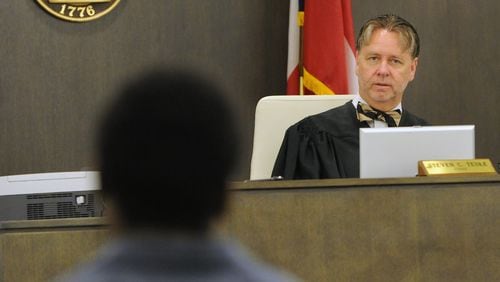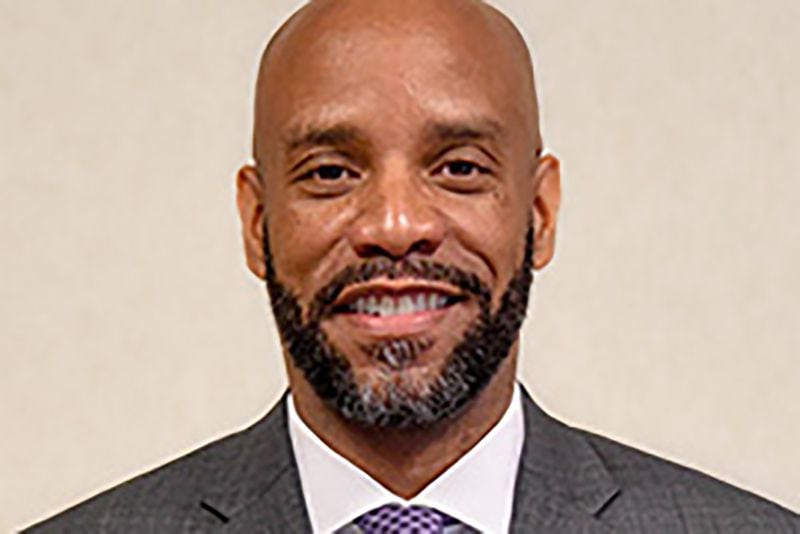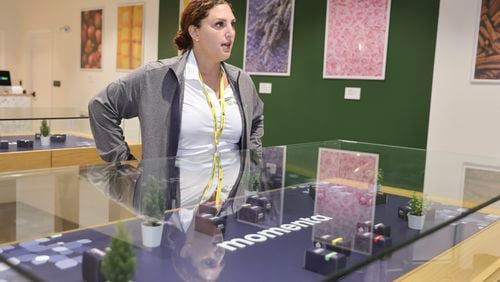A 16-year-old boy sat in juvenile court, nervously awaiting his fate.
The boy, named D’Andre, had been here before. He had completed probation in an earlier case, but now he was in trouble again, this time for attempted burglary. This time, he could wind up in a state juvenile prison.
It’s exactly the outcome that Clayton County tries to avoid. In a state where children as young as 13 can be sentenced to decades behind bars, the metro Atlanta county’s juvenile court judges practice a form of restorative justice aimed at holding young offenders accountable without condemning them to an endless cycle of crime and punishment.
“Most kids age out of delinquency,” Chief Judge Steven Teske said in his chambers one morning before holding court. “We don’t need to interfere with that. Adults have to be tolerant and not go off the deep end and use a hammer on them.”
» RELATED: How fear, politics forged Georgia's punitive juvenile laws
» PREVIOUSLY: Deadly consequences: Murder case exposes a system's failings
Clayton County’s approach, which deemphasizes incarceration of young offenders, is unusual in Georgia but is taking hold in jurisdictions around the country, juvenile justice experts say.
“Folks are looking at the tax dollars and are looking at the outcomes,” said Paul Elam, a juvenile justice advocate who has worked with the Annie E. Casey Foundation and other organizations concerned with juvenile justice. “We were tough on crime, but we weren’t smart on crime.”
Through its “Second Chance Court,” Clayton has reduced its average number of juveniles in detention by two-thirds since the early 2000s. Fewer than one in five youths commit additional crimes, a rate far lower than the statewide average.
Teske said the key is to give youths supervision, counseling and compassion.
Too often, he said, “we’re locking up people for things that make us mad, not things that scare us.”
He might feel angry that a repeat offender like D’Andre has returned to court. But how he handled the case could change the boy’s life — for better, or for worse.
Clean slate
Teske looks like an unlikely evangelist for progressive ideas on juvenile justice.
He is a middle-aged white man presiding in a county where almost three-fourths of residents are African American. When he enters his courtroom, a brightly colored bow tie peeks out of the collar of his black robe.
He realizes that most youths who come into court don’t look like him. During a recess one recent day, Teske told a group of courthouse interns from Clayton State University, all of them African American, that many juveniles who see him on the bench for the first time must say to themselves, “Oh, (expletive).”
But since the early 2000s, Teske has led an effort to change the way young offenders are treated in court. The dominant view for many years, he said, was that changing behavior required consequences and that those consequences needed to be punitive.
Credit: CONTRIBUTED
Credit: CONTRIBUTED
“Consequences alone do not change behavior,” he said. “They aggravate and make it worse.”
Data collected by Clayton’s juvenile probation officers shows that nearly nine in 10 youths charged with crimes experienced trauma in childhood: persistent family violence, abuse, erratic behavior by parents addicted to drugs or alcohol, violent crime on the same streets where they played.
Dealing with those issues, Teske said, usually does more good than putting a youth behind bars. Juvenile court proceedings are generally confidential; the full names of accused teens and family members are kept private, for instance. So a young offender can move on from a mistake with a clean slate.
Clayton has what may be the most effective juvenile court in Georgia, said Tracy Graham-Lawson, who was a juvenile court judge before serving as the county’s district attorney for 10 years.
But it’s not perfect, Graham-Lawson said. As a prosecutor, she was surprised to see defendants whom she remembered from juvenile court.
“It’s pretty disheartening,” she said. “You can’t unring some bells.”
Teske acknowledges this approach requires taking calculated risks. Most youths may never commit another crime — but that is not guaranteed.
“This job requires a heart,” Teske said, “but the heart can never be bigger than the head.”
Breaking the cycle
D’Andre, the 16-year-old accused in the attempted burglary, stared straight ahead from the defense table in Teske’s courtroom. Rail-thin, the boy wore skinny black jeans and a gray shirt buttoned to the neck. His mother sat a few feet away, her brow furrowed, obviously anxious.
A prosecutor opened D’Andre’s hearing by recounting the crime: D’Andre and two other boys broke a window while trying to enter the home in Jonesboro just as the homeowner pulled into his driveway. The homeowner chased the boys through his neighborhood, but D’Andre was the only one he caught.
Teske guided D’Andre through a standard courtroom routine:
Did he understand the charges against him? Yes.
Was he on drugs? No.
Did he waive his constitutional right for a trial? Yes.
Teske turned to D’Andre’s mother: “Do you feel confident with what’s going on?”
“Yes, sir,” she said.
Had she been treated “respectfully and fairly” by court employees?
“Yes, sir.”
“You would tell me, though, if you hadn’t?”
“Yes, sir,” she said, a smile breaking through for a moment, and she mentioned she had met Teske before.
As the hearing continued, D’Andre admitted the crime, and a probation officer reminded Teske of the boy’s history — of the fact that serving a probated sentence in an earlier case had not stopped him from committing a new offense.
“I really didn’t think we would see him back here,” the officer said. She seemed to be making a case for a stiff sentence.
But then: “He really is a good kid,” the officer said. “He just needs to stop hanging out with these people.”
She recommended that Teske place D’Andre on unsupervised probation for 12 months. It would give him a chance to keep himself out of trouble without having to regularly check in with probation officers. She also said the boy should replace the broken window.
Teske asked the homeowner to stand. Would that sentence satisfy him?
“I would like to get my window fixed,” he said from the back of the courtroom. But “I don’t want to mess up his future. I’ve been there. I understand.”
The homeowner spoke directly to D’Andre: “At the age of 17, I was sitting in your seat.” He said a judge in Chicago gave him a second chance, and he took it, deciding not to follow so many black men of his generation into long-term incarceration.
“That’s got so many of us locked up,” he said. “Even if you do go into the system, don’t give up.” Get an education, he told the boy. “That’s the only thing that’s going to keep us out of the system. They want to keep us in there.”
He started to sit, but there was one more thing he wanted D’Andre to know: “If I had been home in that house, I would have shot you.”
D’Andre’s mother began crying.
“I was so scared” when D’Andre called to say he had been arrested, she told Teske. Since the arrest, she said, she had home-schooled her son, trying to keep him off the streets and out of trouble. “He is not that type of child. He was at the wrong place at the wrong time.”
Teske imposed the recommended sentence: a year of unsupervised probation. He told D’Andre he expected never to see him back in his court.
“Despite what you did,” he said, “you have a lot of good qualities.”
When the boy’s mother began crying again, Teske stepped down from the bench and hugged her.
“It’s going to be OK,” he said. After a moment, he asked when they had met before.
The mother said that when she was a child, she was removed from her family’s home and placed into foster care. Teske was the judge who presided over her dependency hearing.
Teske held the mother’s shoulders and looked her in the eyes. “You know what you’re doing?” he said. “You’re breaking that cycle.”
He gave the mother his business card, with his personal cell number. Then he shook hands with D’Andre.
“You’ve got a good mama,” Teske told him.
D’Andre turned to his mother and walked with her out of the courtroom. A single tear traced down his right cheek.








